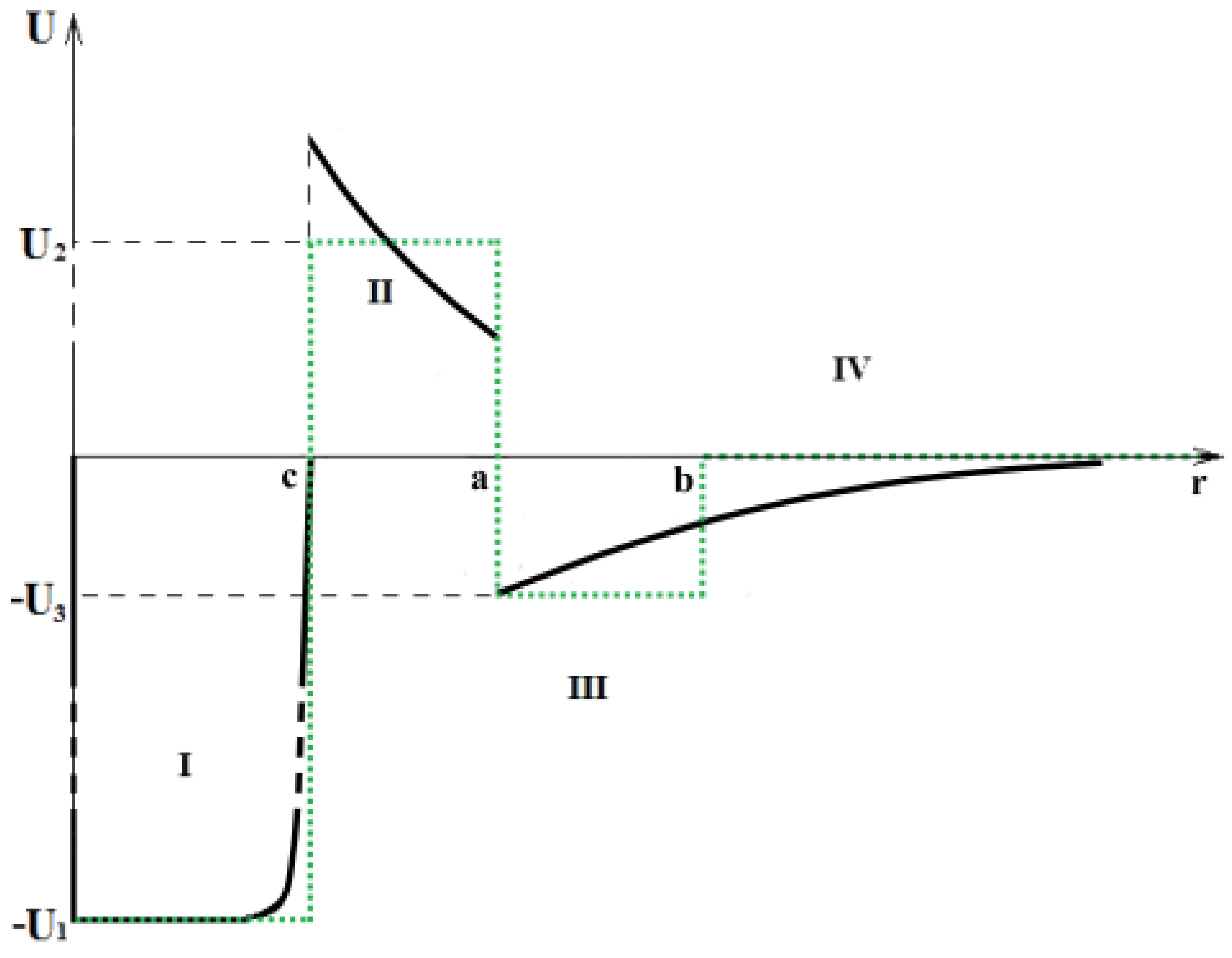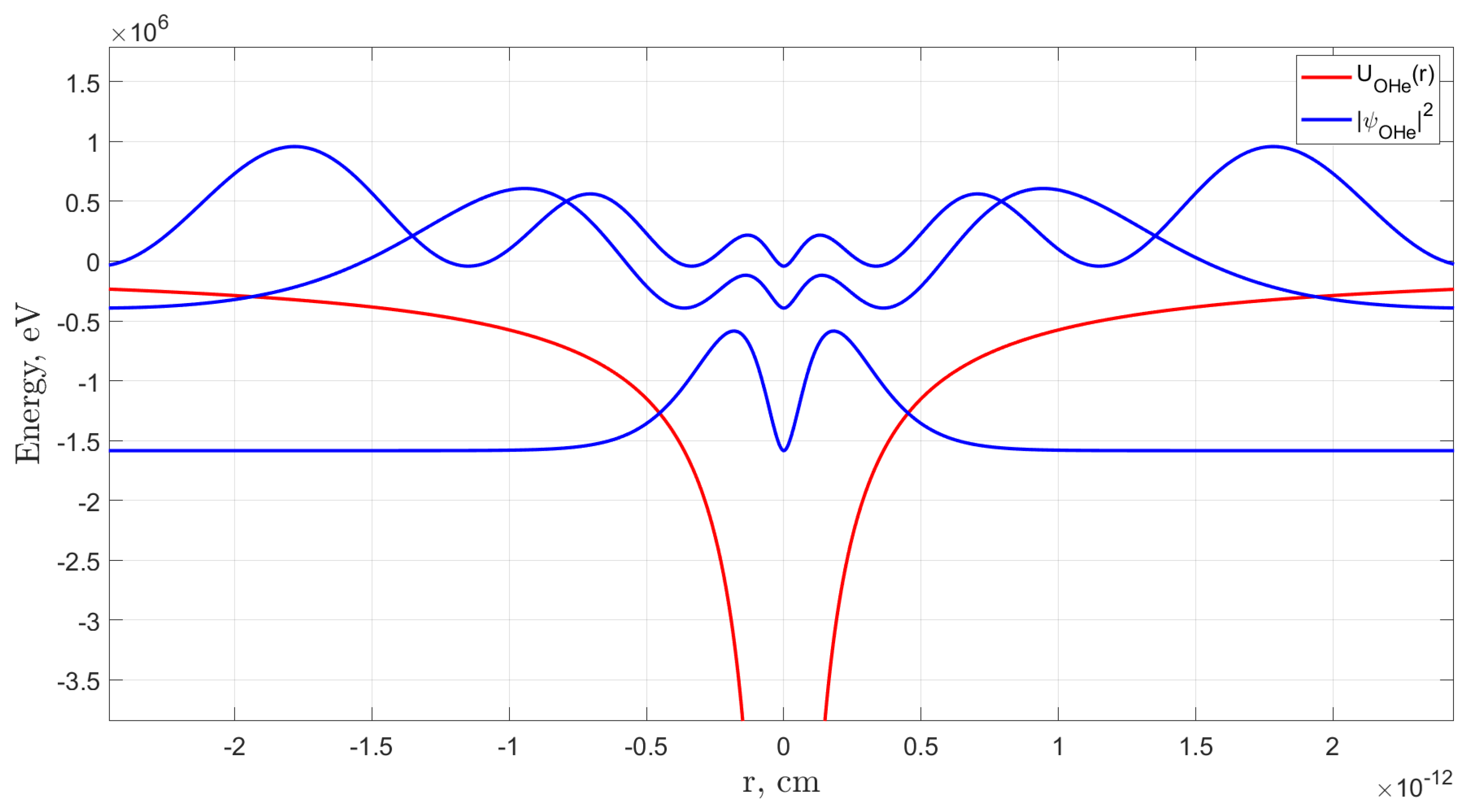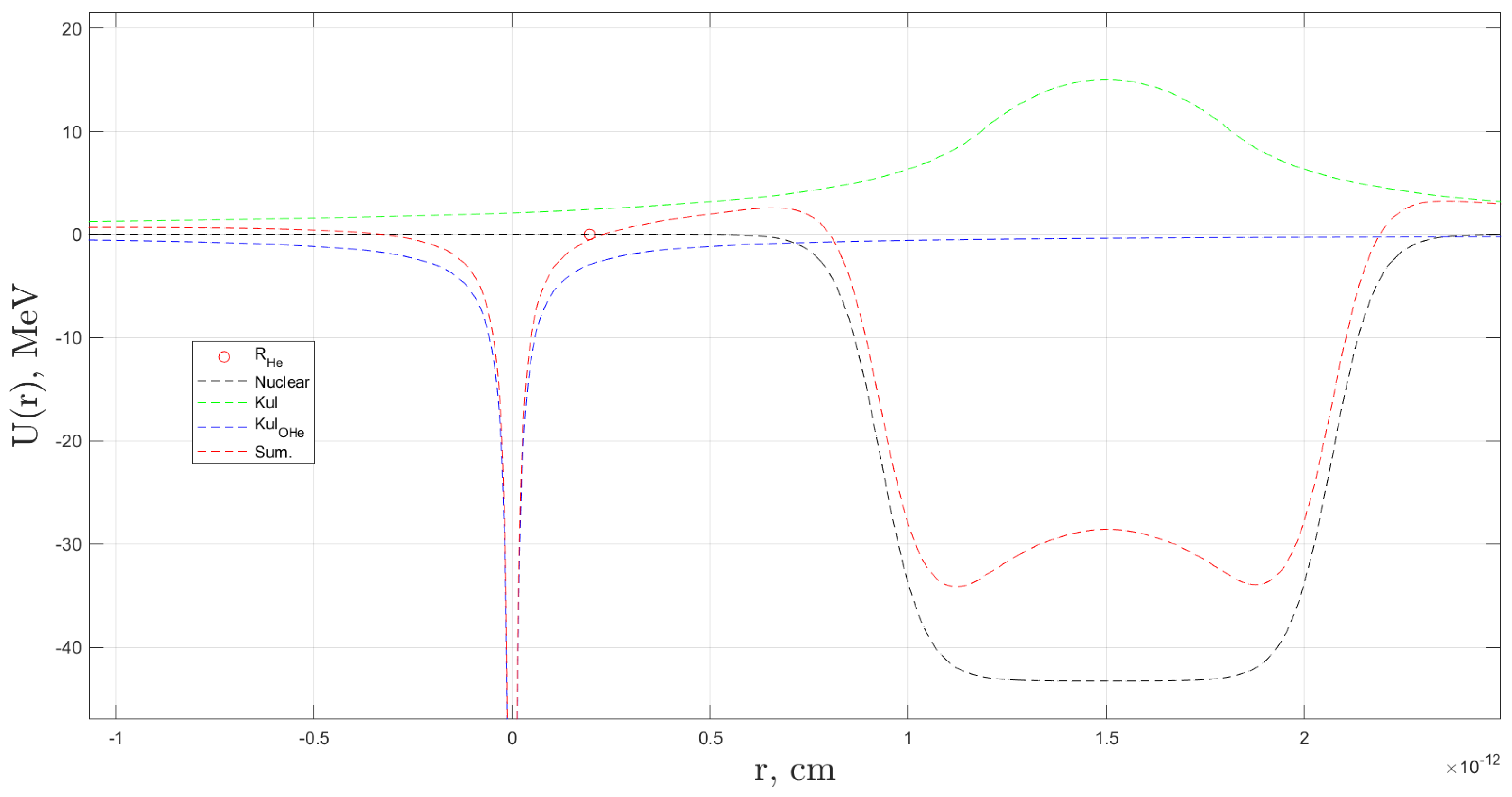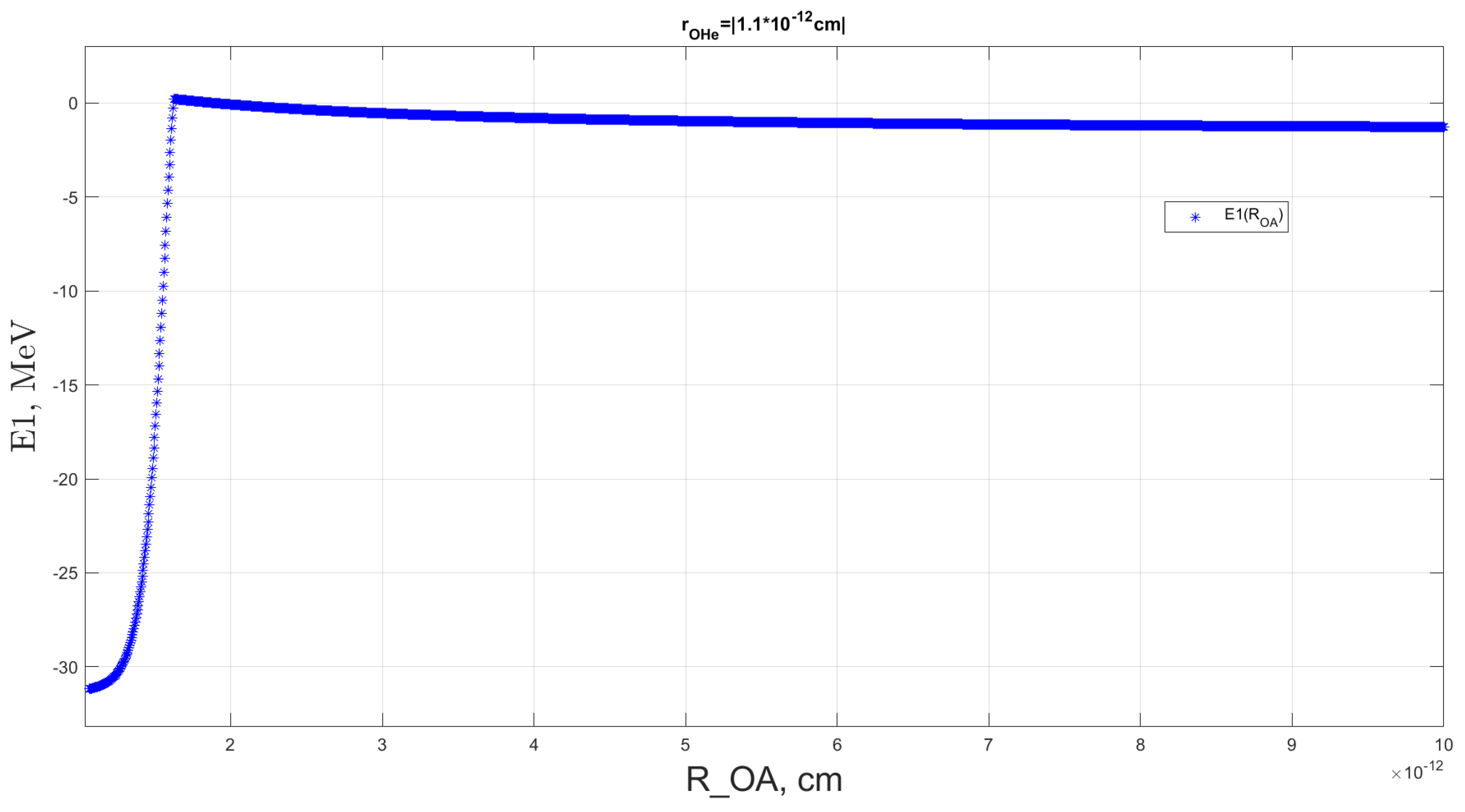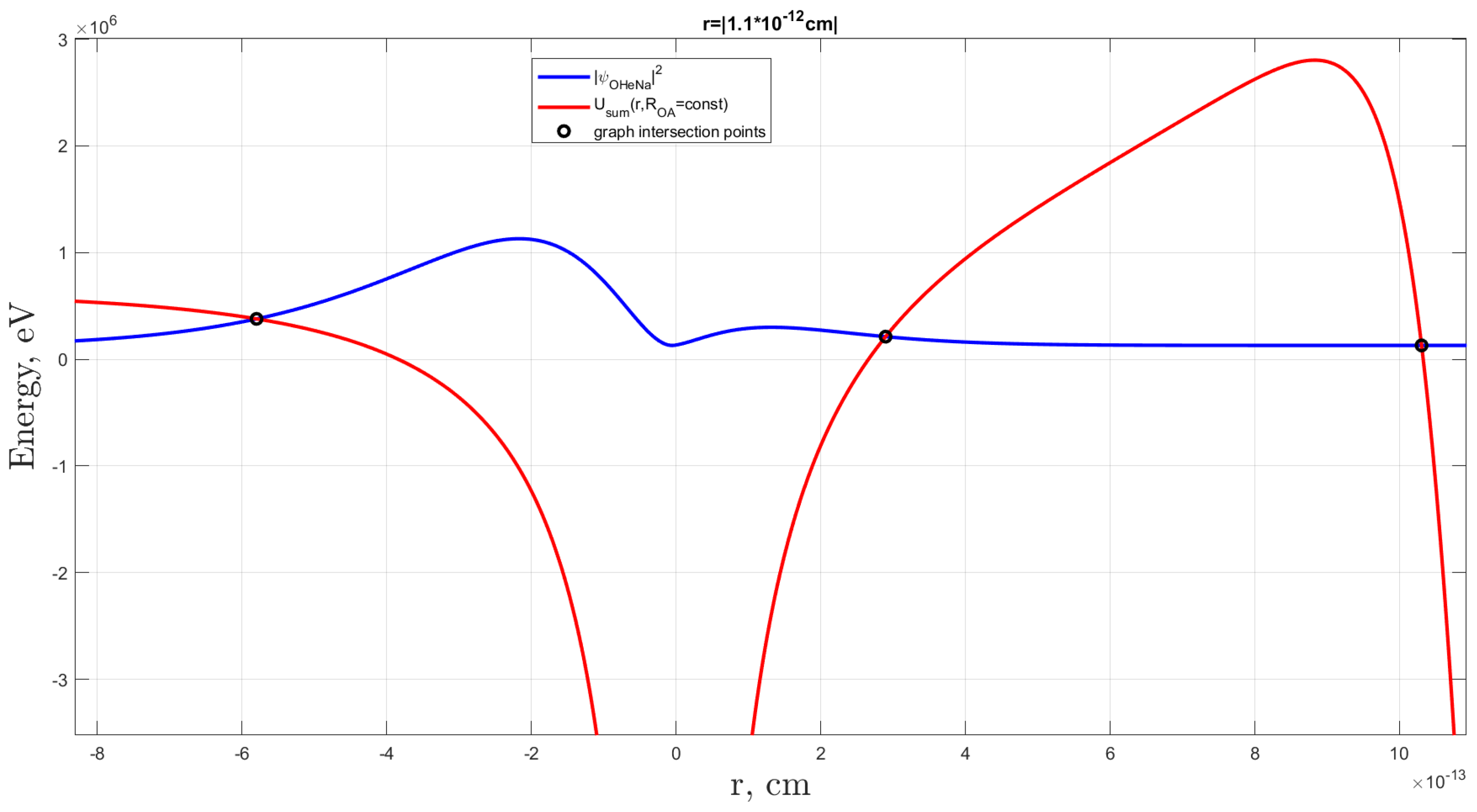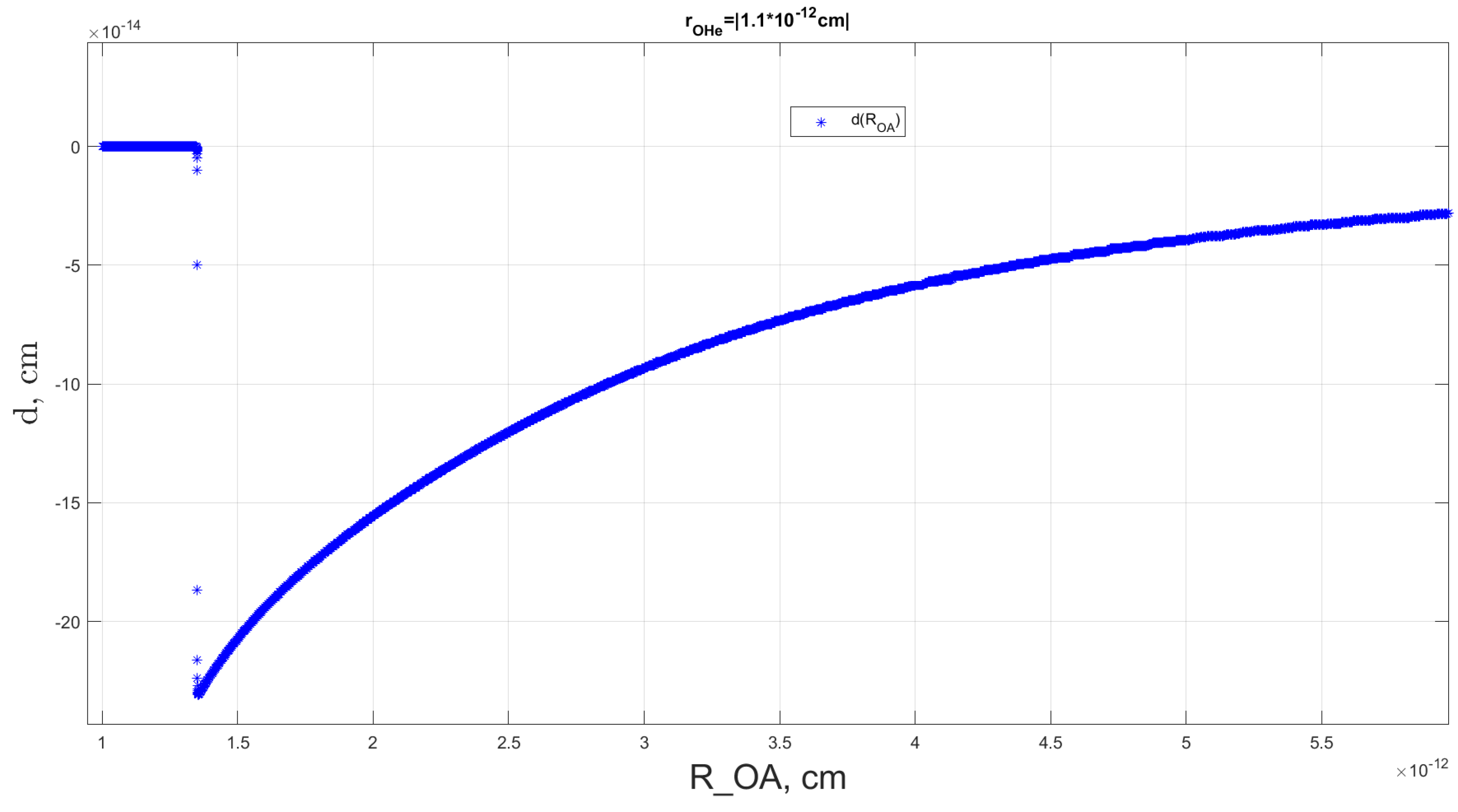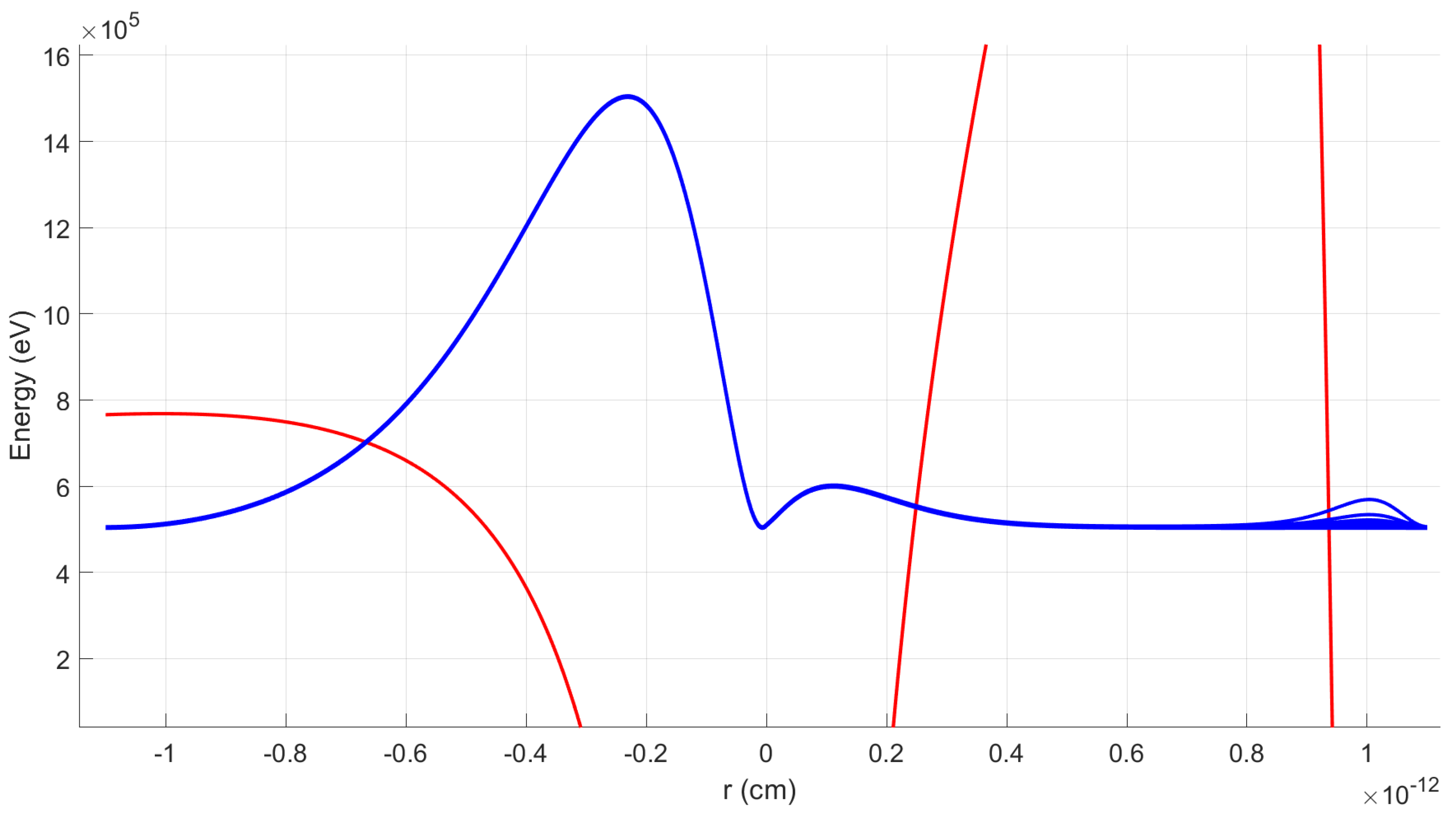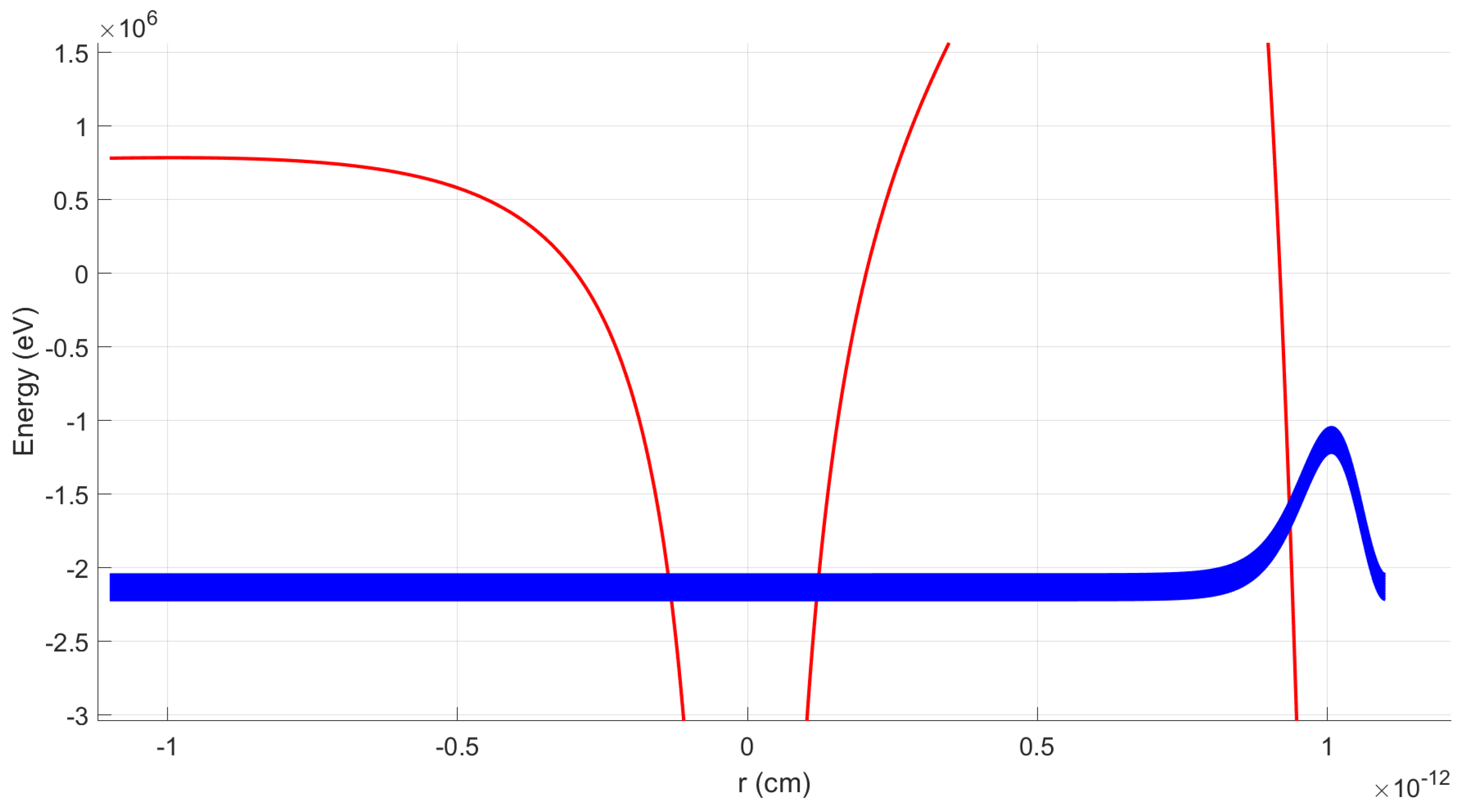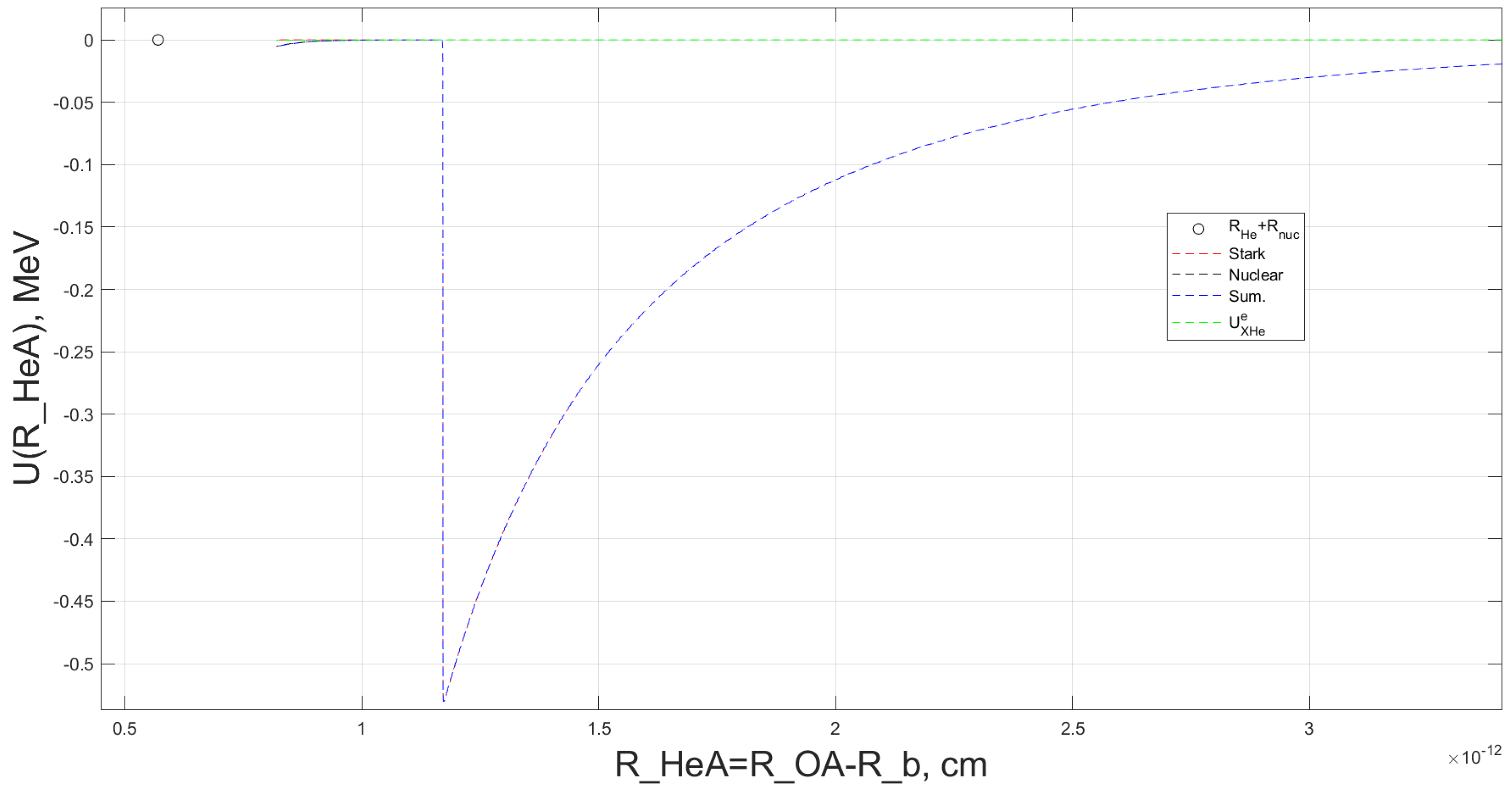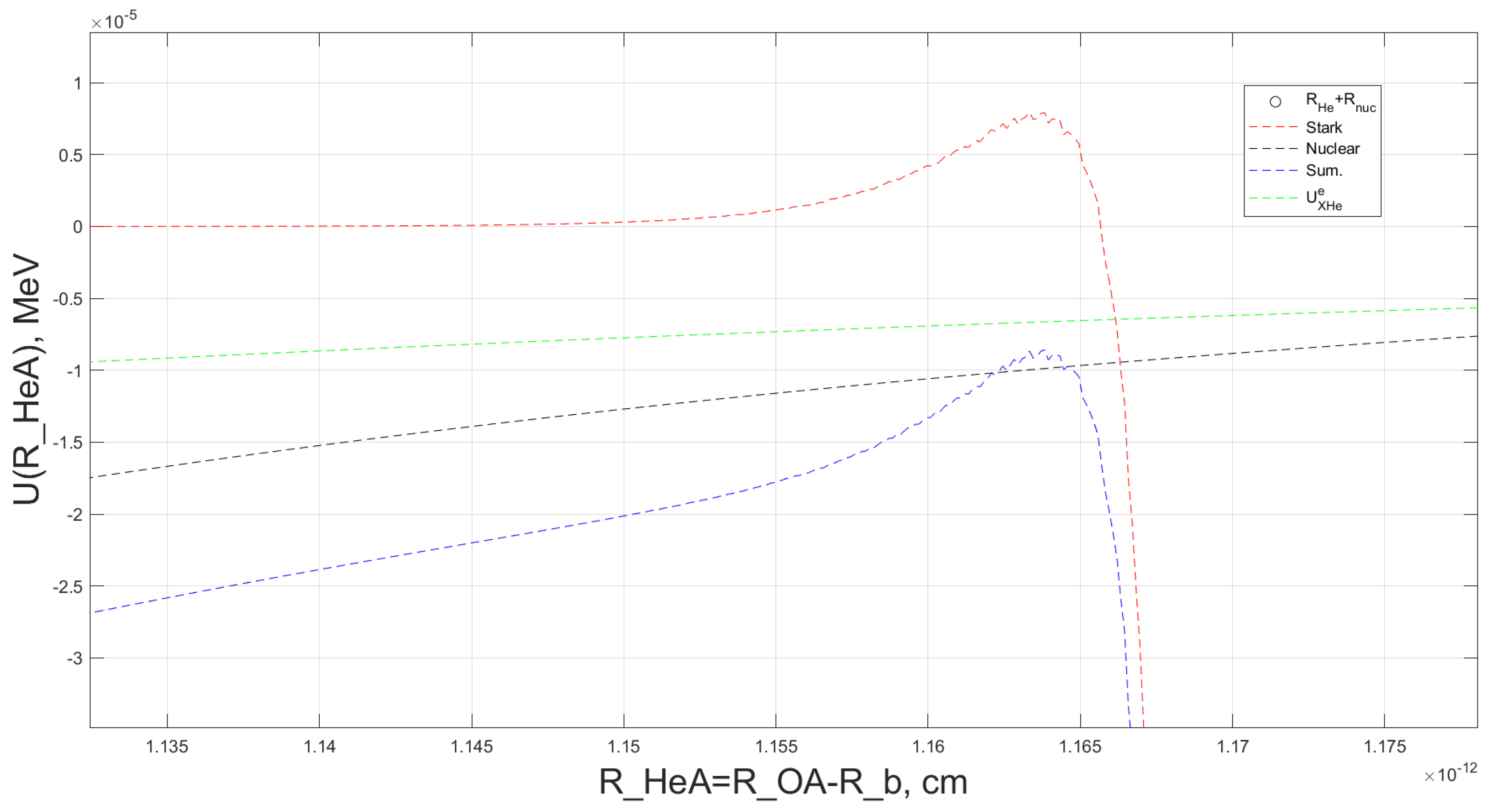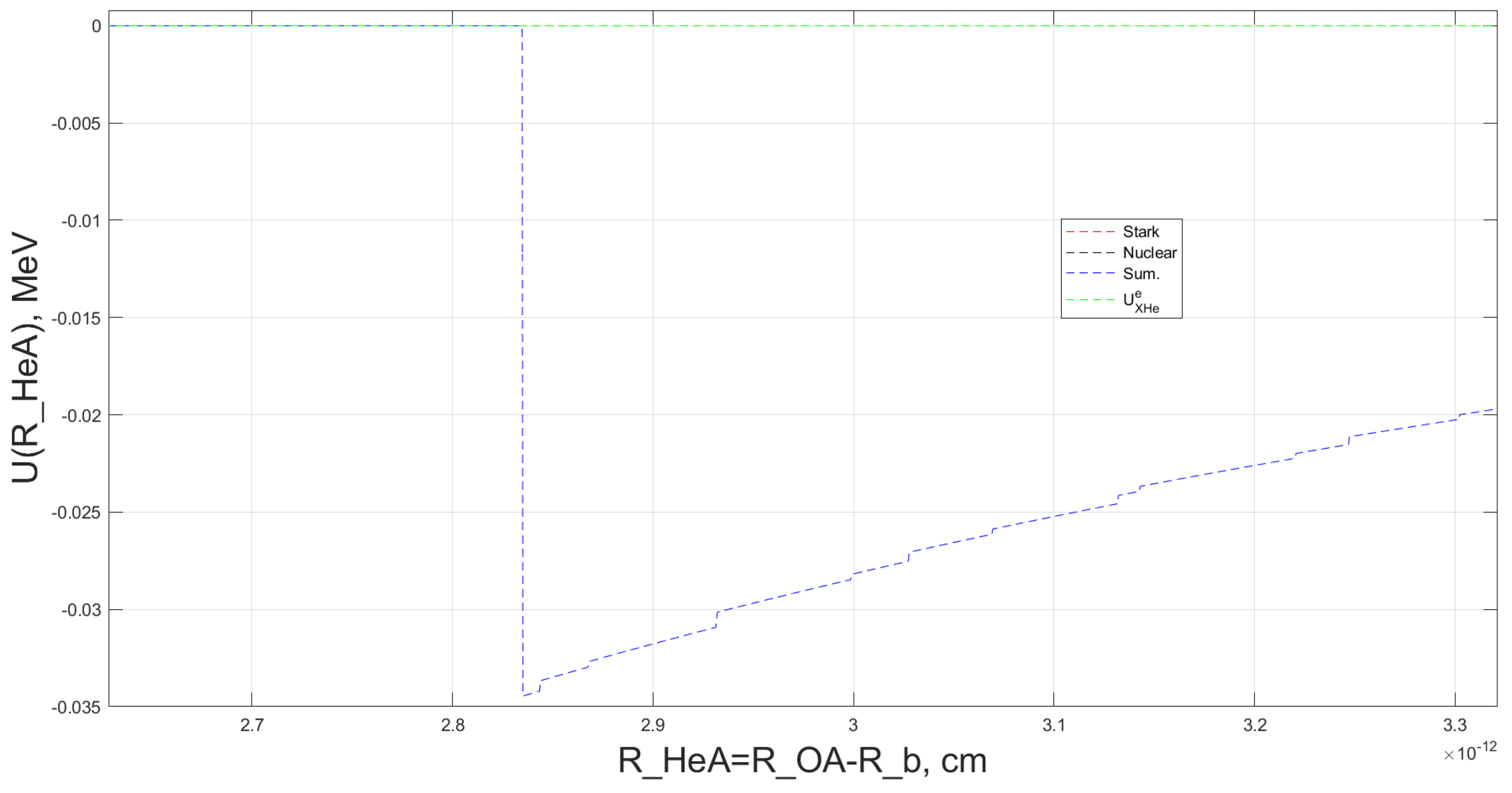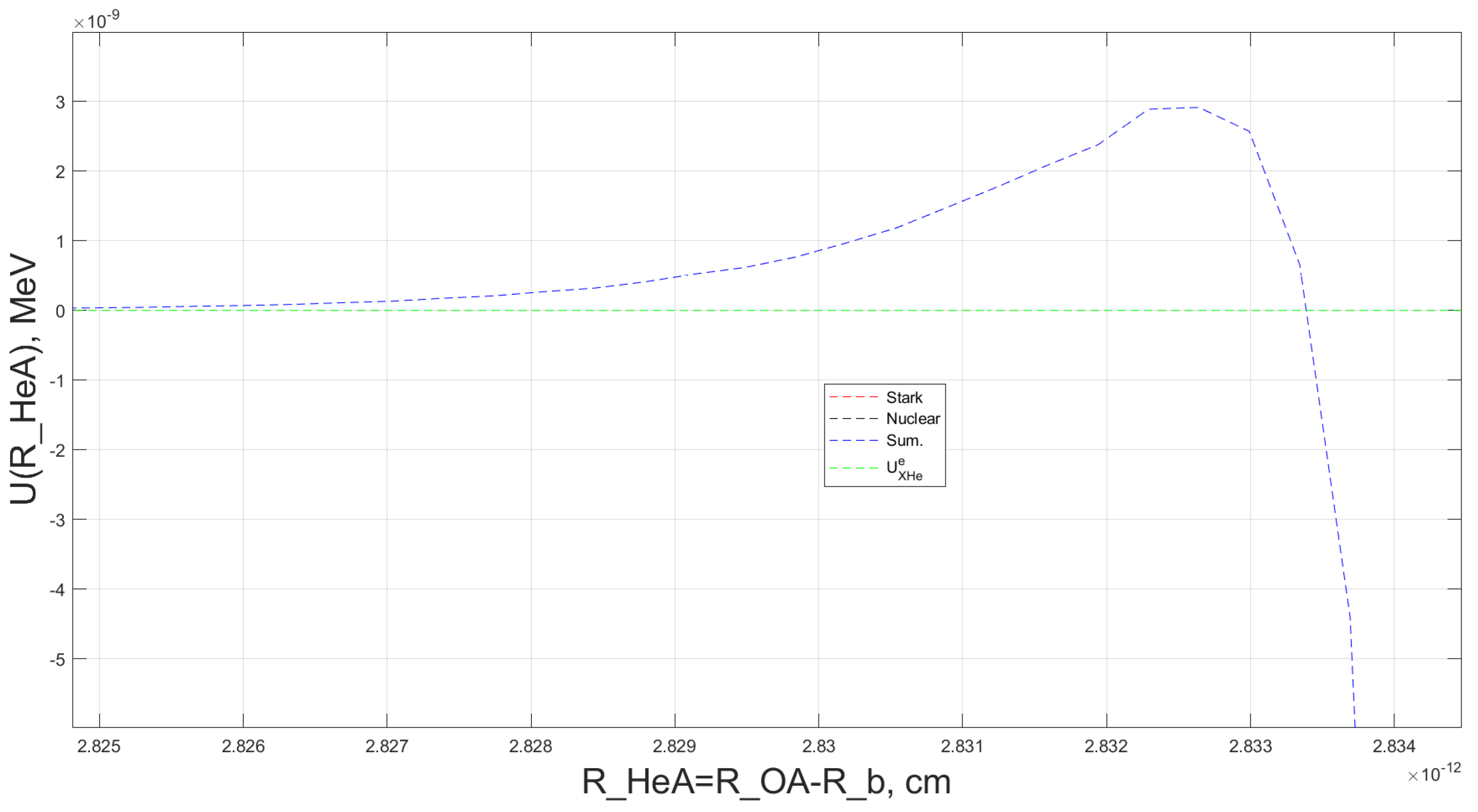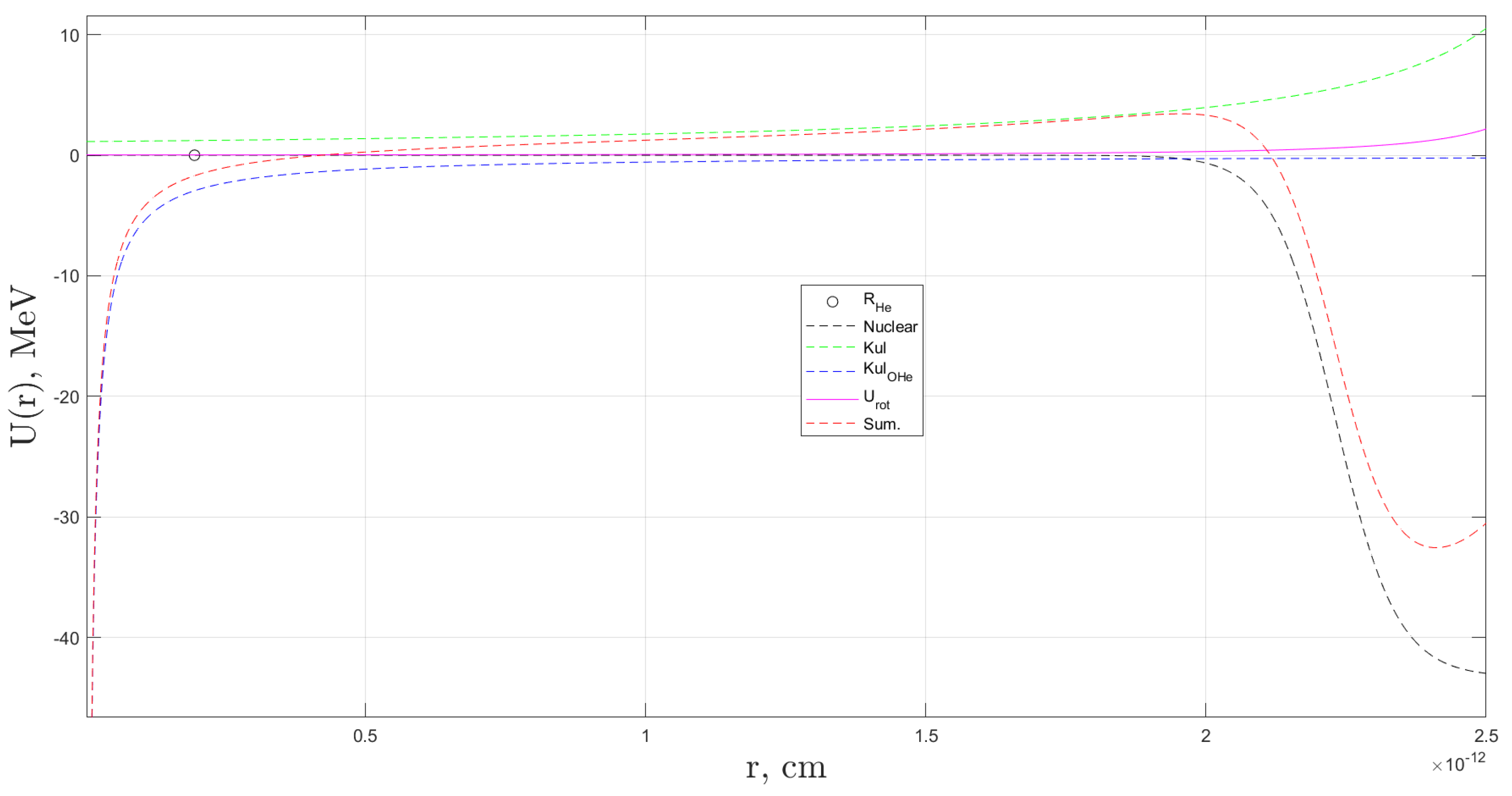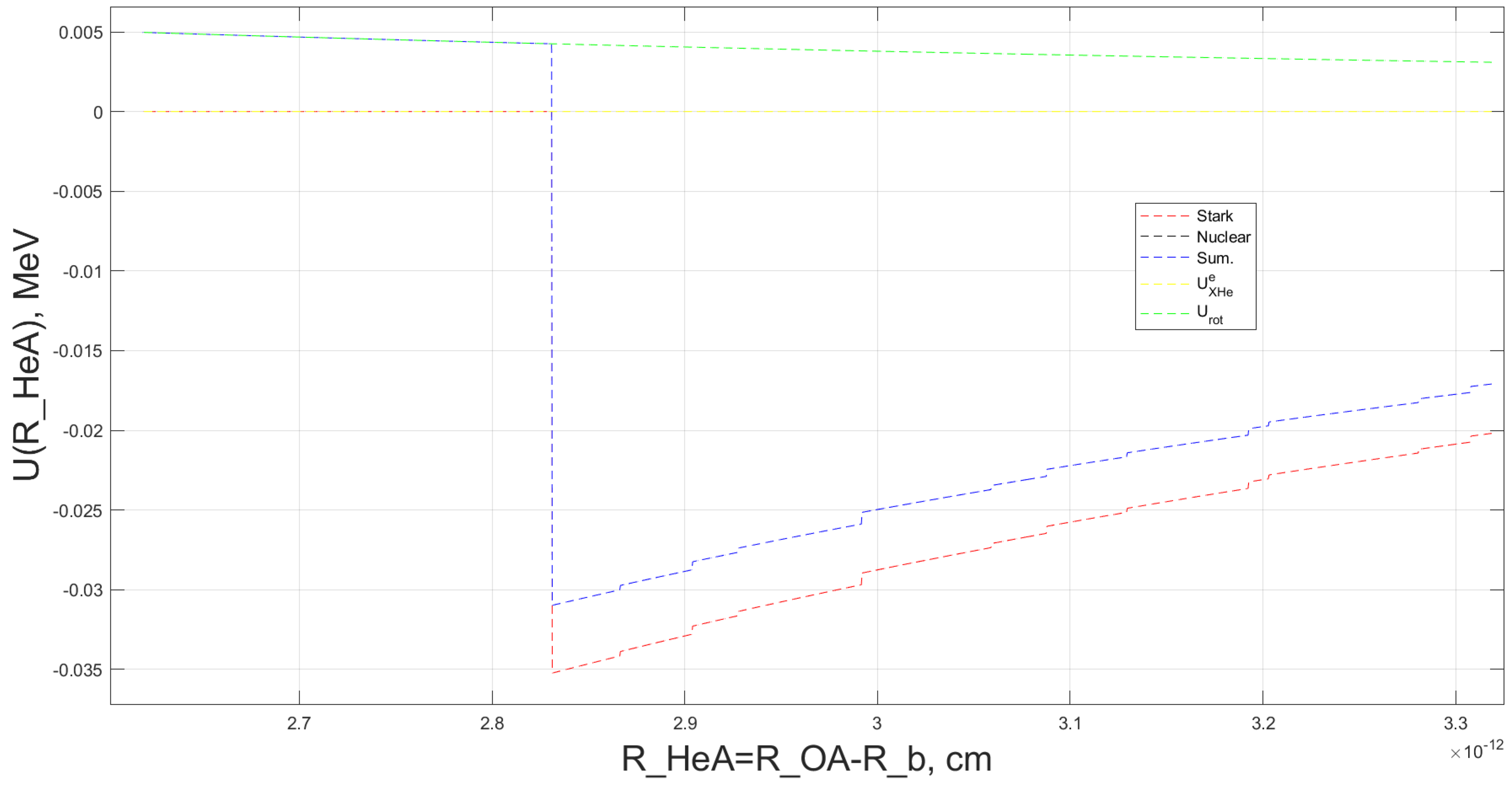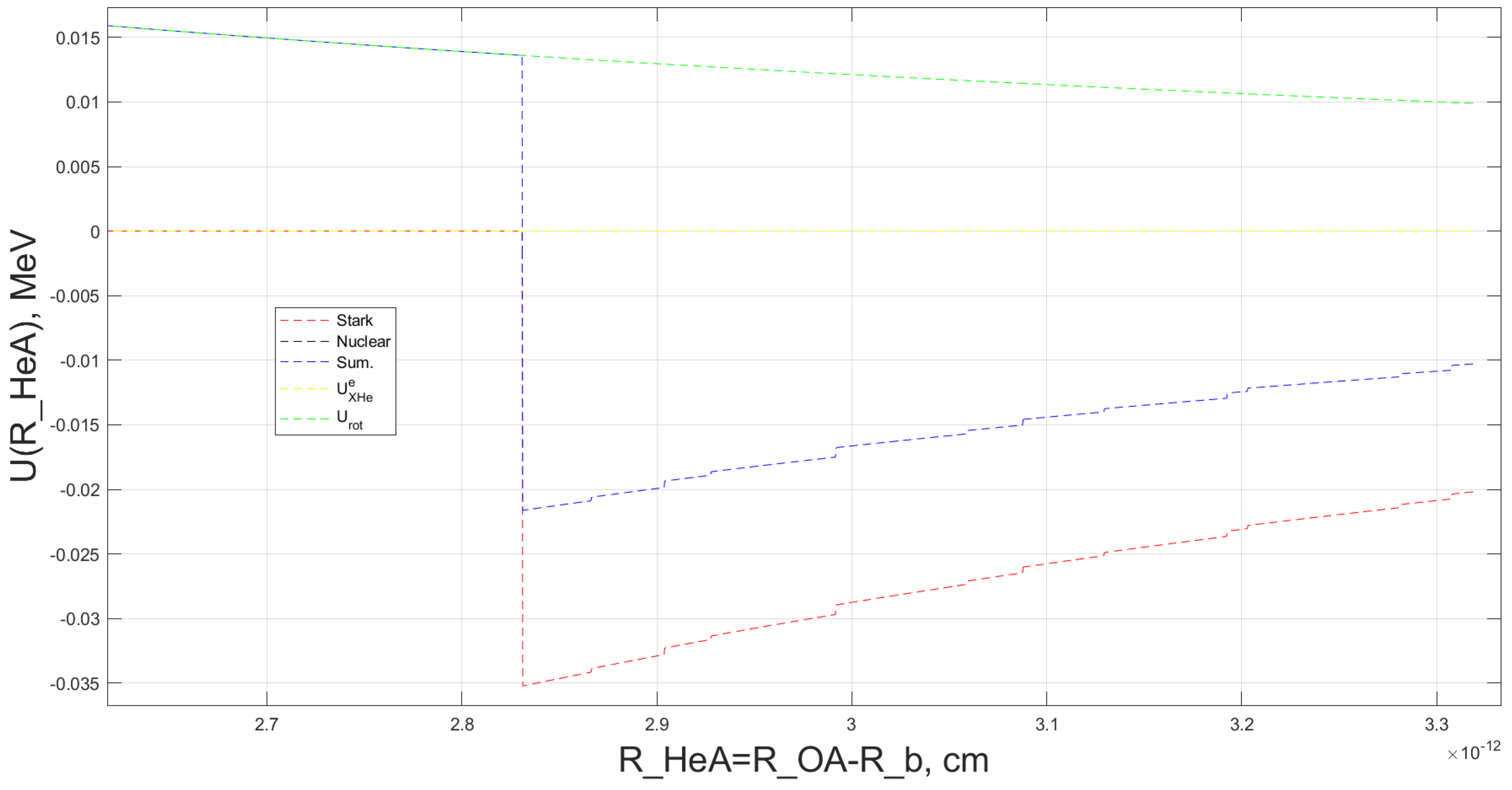5.1. Potential of Interaction of Helium in the Three-Body OHe–Nucleus System
The three-body challenge under investigation is defined by the interaction within the XHe–nucleus system. Consider a particular instance where the XHe dark atom adopts the structure of a hydrogen-like Bohr atom, known as OHe. In this configuration, the coordinate system is anchored at the center of the particle, which forms a bound dark matter atomic structure by interacting with the helium nucleus, treated as a point-like entity, through Coulomb forces. The OHe dark atom is influenced by an external, non-uniform electric field generated by a third particle, the nucleus, characterized by its charge number , neutron count , and mass number A. This nucleus approaches the dark atom quite slowly, engaging in both the electromagnetic interactions and strong nuclear forces.
The Hamiltonian governing the dynamics of the point-like helium nucleus within the OHe–nucleus system can be expressed as follows:
where
characterizes the interaction potential between helium and an external atomic nucleus.
To enhance the clarity of the description, the vectors
,
, and
are defined as follows:
here represents the relative position vector connecting the
particle to the helium nucleus,
indicates the location of the external nucleus, and
is the distance between the centers of helium and the nucleus of matter. These vectors are interconnected by the following relationship:
Consider the following equations for
and
:
where
is expressed using the Woods–Saxon potential. Additionally,
represents the Coulomb potential characterizing the interaction between the point-like helium nucleus and the extended nucleus of ordinary matter.
The nuclear interaction potential is determined based on the distance between the neutron distribution surfaces of the nuclei involved. In particular,
is expressed by the following equation:
where
and
denote the root-mean-square radii associated with the neutron distributions in the heavy nucleus and the helium nucleus, respectively. The parameter
represents the depth of the potential well, with a value of approximately of 43 MeV for the sodium nucleus, while
p is the diffuseness parameter of about
.
The radii
and
are determined according to the following equations [
26]:
where
represents the deformation parameter for both the helium nucleus and the matter nucleus. Specifically, the sodium nucleus is assigned a deformation parameter value of
, while the helium nucleus is modeled as having a spherical symmetry, corresponding to a deformation parameter of zero. The parameter
is the half-radius of the neutron distribution in the helium and matter nuclei and is determined by the number of neutrons
N and protons
Z in the nucleus and is calculated using the following expression:
where the parameter
is dimensional constant that depends on
Z and
N in the respective nucleus and is expressed by the following relation:
For the Coulomb interaction potential
between the point-like helium nucleus and the nucleus of the heavy element, where the radius is taken as the root-mean-square radius of the proton distribution
, the potential is determined by the following equation:
where
is defined by the following expression [
26]:
where the parameter
represents the half-radius of the proton distribution in the nucleus and is calculated based on the charge number
and the number of neutrons
in the heavy element nucleus as follows:
whereas
is dimensional constant, also dependent on the proton and neutron numbers of the nucleus, and is expressed by the following relation:
Thus, the Hamiltonian operator for the helium nucleus within the OHe–nucleus system is governed by the radius vectors and . However, by fixing the position of and altering the location of the substance’s nucleus, i.e., varying , one can derive a series of Schrödinger equations that depend exclusively on . Each of these equations corresponds to a specific configuration of the external nucleus relative to the dark atom.
Hence, the Schrödinger equation to be solved is expressed as follows:
which can be expressed as follows:
By approximating the Hamiltonian operator using the finite difference method in matrix form, it becomes feasible to numerically calculate the eigenvalues of the operator , which correspond to the energy levels E of helium within the OHe–nucleus system for a given fixed position of the external nucleus . Additionally, the eigenvectors of the Hamiltonian, which describe the wave functions of the helium atom in this system, are determined.
To achieve this, it is necessary not only to represent the Laplace operator
in matrix form but also to construct the matrix representation of the interaction potential between the helium nucleus and the external nucleus in the OHe–nucleus system for each specified value of
, as follows:
Figure 3 shows an example of the reconstructed total interaction potential,
, for helium in the OHe–Na system. This potential is displayed as a function of the helium radius vector
, while the radius vector
of the external sodium nucleus is kept fixed.
As shown in
Figure 3, the interaction potentials highlight the contributions of the Coulomb and nuclear forces between the helium and sodium nuclei, alongside the Coulomb interaction between helium and the
particle. The total effective potential for helium within the OHe–Na system is also depicted.
To address the quantum mechanical three-body problem in the OHe–nucleus system, it is necessary to solve the Schrödinger equation for the helium nucleus under the assumption of a fixed position for the external nucleus, . This involves constructing the Hamiltonian of the helium nucleus in matrix form, enabling the numerical computation of its eigenvalues and eigenvectors. The eigenvalues represent the discrete energy states of helium, while the eigenvectors correspond to the helium -functions within the OHe–nucleus system.
5.2. The Solving of the Schrödinger Equations for Helium Within the OHe–Nucleus System
In the absence of an external nucleus, the dark matter atom remains in an unpolarized state, with the ground-state energy level of helium in the OHe system being approximately
. When external nucleus approaches, the dark atom becomes polarized due to the electric field generated by the external heavy nucleus, leading to the onset of the Stark effect. As a result, OHe develops a non-zero dipole moment and begins to interact with the external nucleus as a dipole. This interaction is described by the Stark potential (see Equation (
1)). In accordance with the dark atom model, the effective interaction potential between OHe and the external heavy nucleus is expected to give rise to a dipole barrier, which prevents dark matter particles from entering the nucleus. Furthermore, a low-energy bound state is anticipated to form between the dark atom and the external nucleus.
To solve the one-dimensional Schrödinger equation for the helium in the OHe–nucleus system, as expressed in Equation (
18), it is crucial to establish the range of values for the helium radius vector,
while maintaining a fixed position for the external nucleus,
. In this framework,
functions as an free variable influencing the total interaction potential experienced by the helium nucleus within the OHe–nucleus system for a specified position of the nucleus of matter.
The solution process entails addressing this set of equations, which involves the Schrödinger equation corresponding to each specific position of the external nucleus, which is considered to move slowly. Therefore, it is also essential to define the interval for the radius vector of the external nucleus to comprehensively describe the interaction dynamics in this three-body system.
Setting to fully overlap with would quite probably place helium in the deep potential well generated by the heavy nucleus. Since the initial position of the helium nucleus is within the dark atom—where OHe exists as bound quantum mechanical system before interacting with the heavy nucleus—the intervals for and should be selected such that their boundaries are close but do not overlap. This approach allows the helium nucleus to initially remain within the dark atom, gradually sensing the influence of the approaching nucleus and, as it nears, to begin tunneling into the nucleus through the Coulomb barrier with increasing probability. Thus, for the given interval , with boundary points equal in magnitude but opposite in sign, the interval is configured to begin at the maximal distance from the dark atom and to conclude near the right endpoint of the helium radius vector interval. That is, the radius vector of helium is given as and the radius vector of the outer nucleus of matter as , where and . Thus, the fixed position of the nucleus of the substance, , consistently takes values from the interval , starting from point c to point b. And for each point , the distance between the helium nucleus and the nucleus of matter, , varies in the interval . As the external nucleus approaches the dark matter atom, the polarization of OHe intensifies, responding to the proximity of the nucleus.
As the nucleus of the substance moves closer to the OHe system, the ground state of the helium nucleus in the dark atom undergoes the corresponding modifications. To evaluate the variation in the dipole moment of the polarized OHe, it is essential to compute the changes in both the ground-state energy and the wave functions of the polarized dark atom. By incrementally decreasing the distance between the external nucleus and OHe and solving the Schrödinger equation for helium at each fixed value of the radius vector of the external nucleus, the complete energy spectrum of helium within the polarized OHe system was determined for each specific position of the outer nucleus. In these computations, the external nucleus was consistently assumed to be .
Figure 4 illustrates the dependence of the helium ground-state energy in the polarized dark atom on the radius vector of the sodium nucleus within a range where the helium radius vector is
.
In
Figure 4, the blue stars indicate the ground-state energy levels of helium within the polarized OHe, calculated for the various fixed values of the sodium nucleus’ radius vector,
. The graph illustrates that when the external nucleus is positioned far from OHe, the dark atom exhibits behavior nearly identical to that of an isolated system. Under these conditions, the ground-state energy of helium stabilizes around
, which corresponds to the binding energy of the OHe. However, as the sodium nucleus approaches, the polarization of OHe intensifies, leading to a shift in the helium ground-state energy toward positive values. At close enough separations, the probability of helium tunneling into the sodium increases significantly, with the energy levels converging to a value determined by the square of the modulus of the wave function at the point where helium is most probably in the middle of the sodium.
Consequently, by solving the Schrödinger equations for He in the OHe–Na system for the various fixed positions of the external nucleus, , the ground-state energy spectrum of helium in the polarized dark atom was determined, along with the corresponding wave functions associated with these energy states.
5.3. Calculation of the Values of the Dipole Moment of Polarized Dark Atom
Using the normalized ground-state wave function of helium in an unpolarized dark atom,
, which was obtained by solving the Schrödinger equation for helium in an isolated OHe dark atom, along with the normalized wave functions of helium in a polarized dark atom corresponding to the various ground-state energy values,
, we calculated the spectrum of dipole moment values
for polarized OHe. The dipole moment
for the given
was calculated by the following equation:
To evaluate the integral in Equation (
20), it is essential to precisely establish the integration limits. This requires considering the spatial probability distribution of helium within the polarized dark atom, as the goal is to calculate its dipole moments. The integration boundaries are determined by locating the points of intersection between the curve representing the squared modulus of the helium wave function and the curve depicting the total interaction potential for He in the OHe–Na system at the fixed position of
.
Figure 5 demonstrates the procedure of determining the integration boundaries needed for calculating the integral in Equation (
20). In
Figure 5, the red solid curve represents the total interaction potential of helium within the OHe–Na system for a specific fixed position of the sodium nucleus,
. The blue solid curve illustrates the squared modulus of the helium ground-state wave function at the same fixed
. The intersection points of these two graphs, marked by black circles, define the integration limits. Specifically, the first two intersections, moving from left to right, establish the bounds for Equation (
20). In the example shown in
Figure 5, the dark atom is in a state of negative polarization. This is indicated by the higher probability of finding helium on the left-hand side of the origin (the position of the
particle) compared to the right. The sodium nucleus is situated at a distance where helium begins to sense the nuclear potential, as evidenced by the formation of a potential well on the right-hand side of the Coulomb barrier. However, the nucleus remains far enough away to prevent significant tunneling of helium through the barrier.
After determining the range of dipole moment values,
, for the polarized OHe dark atom at various fixed positions of the sodium nucleus,
, one can represent the relationship between the dipole moment of the polarized dark atom and the radius vector
(see
Figure 6).
In
Figure 6, the blue stars depict the calculated dipole moment values for the polarized OHe, each corresponding to specific fixed positions of
within the interval where the helium radius vector is
.
Figure 6 shows that when the sodium nucleus is far from OHe, the dark atom behaves nearly as an isolated system, with its dipole moment approaching zero. However, as the sodium nucleus approaches the OHe, the polarization of OHe increases significantly, resulting in a progressively more negative dipole moment. This phenomenon occurs because the repulsive Coulomb force exerted by the sodium nucleus pushes helium preferentially to the left-hand side of the
particle. When the sodium nucleus is positioned quite close to the dark atom, such that
approaches the rightmost boundary of the helium radius vector interval
, the nuclear interaction between helium and sodium dominates their Coulomb interaction, causing
to trend back toward zero.
At a particular point, the likelihood of helium tunneling into the nucleus of the sodium increases significantly, resulting in a reversal of the dipole moment’s sign, making it positive (see
Figure 7). Until this stage, the probability of helium remaining within the confines of the dark atom does not vanish, signifying that the OHe atom remains intact but undergoes a change in polarization. In this arrangement, the He nucleus is positioned between the
and the nucleus of the substance. Consequently, a dipole-induced Coulomb repulsion may develop between the helium and the sodium nucleus. This interaction, driven by the dipole coupling of the OHe atom with the external nucleus, can facilitate the emergence of a low-energy bound state in the OHe–Na system.
The reversal of the dipole moment’s sign aligns with the theoretical expectations. At large distances between the matter nucleus and the OHe, the repulsive Coulomb force acting on helium dominates over the nuclear attraction. In this scenario, helium is displaced further from the heavy nucleus, while the is drawn toward the sodium by the Coulomb interaction. As the sodium nucleus approaches the OHe, the nuclear forces become increasingly prominent, positioning helium between the and the sodium, as predicted. This shift is manifested as a change in the sign of the dipole moment.
Despite of this, the dipole Coulomb barrier introduces a repulsive force that prevents helium from fully merging with the sodium, thereby preserving the structural stability of the dark atom of the dark matter. As the vector
decreases further, bringing the sodium even closer to the OHe, the dipole moment progressively decreases, approaching zero (see
Figure 7). This trend reflects helium’s deeper penetration into the sodium, which increases the possibility of quantum tunneling. Simultaneously, the probability of helium remaining confined in the OHe diminishes, causing the dipole moment to approach zero.
Figure 8 presents initial plots of the squared modulus of the helium
-functions (depicted by the blue solid line) corresponding to the ground-state energy levels within the total interaction potential of the OHe–Na system (indicated by the red solid line). These representations are associated with particular fixed positions of the sodium, marking the beginning of the OHe repolarization process. During this phase, the dipole moment begins to shift from its maximum negative value toward positive values, signaling an increased probability of helium tunneling into the sodium nucleus of matter by overcoming the Coulomb barrier. This progression ultimately results in the reversal of the dipole moment’s sign to positive, as evidenced by the dependence of the dipole moment on the sodium position shown in
Figure 6 and
Figure 7.
Figure 9 displays the additional plots of the squared modulus of the He
-functions (depicted by the blue solid line) corresponding to the ground-state energy levels in the helium total interaction potential (illustrated by the red solid line). These plots pertain to the specific configurations of sodium as helium transitions to a high-probability tunneling state from the repolarized OHe into sodium. At this stage, the dipole moment decreases from its peak positive value toward zero, coinciding with a significant reduction in the likelihood of helium remaining confined within the OHe. This phenomenon is further illustrated by the relationship between the dipole moment and the sodium position vector shown in
Figure 7.
5.4. Reconstruction the Effective Interaction Potential of the OHe–Na System
To reconstruct the Stark potential (
1), which represents the electric interaction between dipole of dark atom (polarized dark atom) and the nucleus of matter, we utilize the quantum mechanically computed dipole moment values. Additionally, to obtain the complete effective interaction potential for the OHe–Na system, that is, the total interaction potential of the sodium nucleus with the dark atom of OHe, one must also reconstruct the nuclear interaction potential, adopting Woods–Saxon model for the helium and sodium nuclei, along with the electrical interaction potential
of the unpolarized OHe dark atom with the sodium nucleus.
In order to restore the shape of the interaction potential
, one needs to calculate the electric potential,
, that creates unpolarized dark atoms as a whole in a general case, that is, for the XHe dark atom at distance
r from the center of the X particle, in which we place the nucleus of the substance. To do this, one needs to solve the self-consistent Poisson equation for the test wave function
, where
is free parameter, as follows:
where the prime denotes the derivative with respect to
r, and
is the charge density of
n–He:
As a result, by solving Equation (
21), one obtains the electric potential created by the unpolarized dark atom XHe, consisting of the spherically symmetric uniformly charged nucleus
n–He with radius
and particle X, taking into account the screening effect of the nucleus
n–He on the particle X, as follows:
Therefore, the potential of the electrical interaction between the unpolarized XHe dark atom and the nucleus of substance is given by the following expression:
where
is the charge number of the nucleus of matter.
Thus, the potential is derived from solving the self-consistent Poisson equation while accounting for the screening effect of the particle by the He nucleus, an effect that significantly diminishes with distance due to exponential decay.
Summing the nuclear interaction potential of the Woods–Saxon type,
and
yields the total effective interaction potential form for the OHe dark atom’s interaction with the sodium nucleus (see
Figure 10).
In
Figure 10, the blue dotted curve represents the total effective interaction potential governing the interaction between OHe and the sodium. This potential describes the field in which the sodium nucleus is influenced by OHe. On the given scale, the individual contributions from the Woods–Saxon nuclear potential (depicted as a black dotted line) and
(illustrated by a green dotted line) are minimal and can be considered negligible. As a result, the primary factors defining the depth of the potential well are the total effective potential (shown as a blue dotted line) and the Stark potential (shown as a red dotted line), determined by the negative dipole moment arising from the polarization of OHe. This well exhibits significant depth of approximately of
indicating that a bound state between sodium and the dark atom in this potential—under the given intervals of
and
—would possess relatively high energy, diverging from the lower energy states inferred from the DAMA experiment.
A more detailed representation of the effective interaction potential between OHe and the sodium nucleus can be constructed, especially around the region associated with dark atom repolarization, where the dipole moment shifts to positive values; see
Figure 11.
Figure 11 analyzes the formation of a positive dipole Coulomb barrier within the total effective interaction potential in the OHe–Na system. This barrier emerges based on the ability of the Stark potential’s positive contribution (represented by the red dotted line), resulting from the positive dipole moment of the repolarized dark atom, to effectively oppose the combined negative effects of the nuclear interaction potential (illustrated by the black dotted line) and the electric interaction potential of unpolarized OHe with sodium,
(depicted by the green dotted line).
As depicted in
Figure 11, when the separation between helium and the sodium is approximately
, the peak of the Stark potential remains insufficient to offset the combined negative contributions from the nuclear and the
interaction potentials. This results in negative values for the total effective interaction potential. However, since the
is treated as a freely adjustable parameter in solving the Schrödinger equation for helium at fixed
, this interval can be expanded. By simultaneously increasing the range of
, the interaction distance at which He in the OHe begins to “feel” that the sodium can be extended.
Such adjustments would lead to a decrease in the maximum negative dipole moment of the polarized OHe. The negative dipole moment is primarily influenced by the Coulomb interaction between the helium and sodium nuclei, which diminishes as the separation between these nuclei occurs. Thus, the minimum of Stark potential, which determines the depth of the potential well in the effective interaction potential of the OHe–Na system, would become less.
Furthermore, extending the and adjusting the would result in a broader Coulomb barrier in the total effective interaction potential experienced by helium. This modification would alter the helium -functions, thereby reducing the likelihood of helium tunneling into the sodium. Additionally, the positive dipole moment of the repolarized OHe, and the associated Stark potential barrier, would decrease. However, the increased distance between the nuclei would reduce the amplitudes of both the nuclear and the interaction potentials. Consequently, the total effective interaction potential in the OHe–Na system could exhibit the expected positive barrier values.
The OHe model suggests that the dipole Coulomb barrier in the total effective interaction potential of the OHe–Na system is sufficiently large to prevent a direct fusion between the nucleus of matter and the OHe. In the DAMA experiment conditions, the sodium exhibits thermal motion in the OHe–Na system, corresponding to the typical room temperature conditions of approximately . This thermal movement results in a kinetic energy of about 2.6 for the sodium. Consequently, the dipole Coulomb barrier in the effective interaction potential is expected to significantly exceed this energy level, ensuring the stability of the OHe system.
To analyze this phenomenon, the helium radius vector was extended from
to
, while the sodium radius vector was set as
. For each fixed value of
, one-dimensional Schrödinger equations for helium were solved. The dipole moments corresponding to the ground-state energy levels of He in the polarized OHe were then determined. Based on these computed dipole moments, the effective interaction potential between OHe and sodium was subsequently reconstructed, see
Figure 12 and
Figure 13.
As illustrated in
Figure 12, there is a noticeable reduction in the depth of the potential well for the effective interaction potential between the dark atom and the sodium nucleus (blue dotted line). A comparison of
Figure 12 with
Figure 10 reveals that, upon extending the interval
and increasing the sodium position
, the depth of the potential well diminishes significantly, from approximately of 0.5 MeV to about 35 keV.
In
Figure 13, the nuclear potential of Woods–Saxon (represented by the black dotted line) and
(depicted as the green dotted line) diminish to negligible values at a separation approximately of 28.33 fm between the helium and sodium. As expected, the Stark potential emerges as the dominant contributor, establishing a positive potential barrier in the total effective interaction potential for the OHe–Na system. A comparison of
Figure 11 and
Figure 13 demonstrates that extending the interval
and increasing
, representing the sodium nucleus’s position relative to the OHe, results in a reduction in the positive Stark potential barrier. This barrier diminishes from approximately 7.5 eV to about 0.3
, with the change attributed to a decrease in the repolarized dark atom’s dipole moment.
In
Figure 13, the dipole Coulomb barrier in the effective interaction potential is shown to be approximately ten times smaller than the kinetic energy of the sodium nucleus approaching the dark atom under the experimental conditions of the DAMA experiment (about
). However, the depth of the potential well in this interaction remains nearly six times greater than the experimental findings reported by the DAMA experiment (
) and significantly higher than the theoretically estimated binding energy of sodium in a low-energy state with the dark atom (about
). To address these discrepancies, we extend the range of the helium radius vector
, solve the Schrödinger equation for helium within the OHe–Na system, as well as increase
, and thus further decrease the potential well depth and lower the dipole Coulomb barrier, which are already below the predicted values. Improving the accuracy of the numerical model is critical to refining these results, necessitating the consideration of additional effects that influence the interaction between the dark atom and the atomic nuclei. One such effect is the centrifugal interaction potential,
, which may play a role in characterizing the dynamics of the OHe–Na system.
5.5. Incorporating the Centrifugal Potential into the Quantum Mechanical Numerical Model
The centrifugal potential governing the interaction between the OHe and the sodium,
, depends on the total angular momentum of the interacting system,
, as well as the distance,
R, between the two interacting particles. Neglecting the moments of inertia of the nuclei, it is expressed as follows (see Equation (27) in Ref. [
27]):
where
denotes the reduced mass of the system and
c denotes the speed of light.
Since the mass of the OHe is entirely determined by the , which is assumed to have a mass of , and given that the sodium has a significantly smaller mass of approximately , the reduced mass of the OHe–Na system can be approximated as .
The total angular momentum,
, for the interaction between OHe and the sodium nucleus is defined as follows:
where
denotes the orbital angular momentum, which is a function of the impact parameter
,
is the sodium’s intrinsic angular momentum, and
represents the spin of the
He. The
is composed of the spin of the
,
, combined with the intrinsic angular momentum,
, of the He as follows:
Let us consider the specific case of a direct collision between sodium and dark atom. In this head-on interaction, characterized by an impact parameter , the orbital angular momentum of the system becomes zero, . The sodium contributes intrinsic angular momentum which is defined as .
The OHe spin is dictated by the spin of the
, because the He intrinsic angular momentum is equal to
. The spin of
depends on the specific internal structure and properties of this particle. In particle models involving four or five fermion generations, a stable particle with a charge of −2, denoted as
, is theoretically viable and consists of three antiquarks, such as fourth-generation
quarks, formulated as
[
1]. Consequently, if
takes the form of
and includes quarks from these extended families, then
. The walking technicolor (WTC) model, based on SU(2) symmetry, proposes a unique type of interaction that binds a novel type of quarks [
11]. Within the framework of the walking technicolor theory, technibaryons are hypothesized to form from techniquarks that are bound by specific technicolor interaction and charge. If
is identified as a technibaryon, its spin,
, may take on values of either
or
. Additionally, WTC predicts the existence of a fourth generation of technileptons. If
is categorized as a member of the technilepton family, its spin would correspond to
.
In the scenario being analyzed, where the impact parameter satisfies
, the total angular momentum of interacting OHe and the sodium can be expressed as follows:
To account for the centrifugal potential
within the total effective interaction potential of the OHe–Na system, it is necessary to include the centrifugal potential arising only due to the He and sodium interaction, denoted as
. Consequently,
must be added to the total potential affecting the He in the OHe–Na system (see Equation (
19)) for each fixed position of sodium,
, as follows:
where
is given by the following expression:
where
denotes the total angular momentum associated with interaction of He and Na.
is governed exclusively by the intrinsic angular momentum of Na. This arises from the feauture that possesses no intrinsic angular momentum, . Additionally, when Na approaches the helium with , the orbital angular momentum between the two nuclei becomes negligible. Consequently, the total angular momentum for interaction particles simplifies to .
Figure 14 illustrates a representative case of the total interaction potential experienced by He within the OHe–Na system,
. This potential accounts for the inclusion of the centrifugal interaction potential arising from the interaction between the He and Na. The plots are functions of the helium radius vector,
, for a fixed value of
.
Figure 14 illustrates the Coulomb and nuclear interaction potentials between He and Na, alongside the centrifugal potential,
, calculated for
. Additionally, the figure presents the Coulomb potential arising from the interaction between He and the
and, finally, the total effective potential acting on the He in the OHe–Na system.
Ultimately, we calculated the energy values of the ground state of He in polarized OHe through solutions for the Schrödinger equations for He in potentials
. This analysis was conducted for the various fixed positions of the sodium in the range
, as well as for
. Corresponding wave functions associated with these energy values of the ground state were also calculated. Based on this information, dipole moments for each ground-state energy of He in the polarized OHe were evaluated. These dipole moments enabled the reconstruction of the total effective interaction potential in the OHe–Na system. This potential includes
and is presented for two values of the total angular momentum
,
and
; these total angular moments correspond to the following values of the spin of the
particle:
and
, respectively (see
Figure 15 and
Figure 16).
Increase in
and, therefore, the total angular momentum
leads to a substantial amplification of the
within the total effective interaction potential of the OHe–Na system, that, in turn, strongly affects the shape of this potential, as it can be seen in
Figure 15 and
Figure 16. An increase in
quantitatively affects the effective potential by reducing the depth of the potential well and elevating the height of the dipole potential barrier. These changes play a crucial role in preventing both the uncontrolled fusion of the Na with the OHe and the subsequent disintegration of the latter.
The three-body dynamics inherent in the task we are considering necessitate a thorough consideration of the feedback mechanisms among the interacting components of the OHe–Na system, where the outcomes of their interactions directly influence the subsequent behavior of system. The analysis commenced by focusing on the He in the OHe–Na system. The forces acting upon He are systematically evaluated, and the total potential shaping its behavior in this system is reconstructed for each fixed position of sodium. By solving the Schrödinger equations for the total potentials of He, the dipole moments of the polarized OHe was calculated for each fixed . This methodology inherently captures the influence of the Na on the polarization of the OHe, characterized by the dark atom’s dipole moment.
Additionally,
is incorporated, which modifies the structure of the total interaction potential for He. The inclusion of
influences the dipole moment by changing the shape of the helium total interaction potential. Comparison of
Figure 12 and
Figure 16 reveals that the inclusion of
results in a deeper Stark potential well, what can be seen from
Figure 16. Stark potential is closely aligned with the effective interaction potential depicted in
Figure 12. These findings illustrate how
contributes to increasing the negative values of
.
Furthermore, adding into reduces the Stark potential’s dipole Coulomb barrier. This occurs because promotes to increase in the positive value of the barrier in the total potential of helium, thereby reducing the probability of it tunneling into the Na. This highlights the role of Na in modifying the dark atom’s polarization. After that, OHe begins to interact with Na as dipole, and this interaction is expressed by the Stark potential. Beyond the Stark potential, Na interacts with OHe via additional contributions, including the , , and the nuclear potential.
In conclusion, the total effective interaction potential of OHe–Na system, exemplified in
Figure 16, is reconstructed. This potential depends on
, yet its general structure aligns with theoretical predictions. The resulting total effective interaction potential makes it possible to expand the
interval, which facilitates a potential well depth of approximately of 6 keV and potential barrier height surpassing the sodium’s thermal kinetic energy, estimated at about 2.6 × 10
−2 eV. The presence of this positive dipole potential barrier is pivotal in averting the fusion of helium or
particle with the nucleus of a substance, thereby preserving the integrity and stability of the OHe. And it is a critical requirement for sustaining the validity of the OHe hypothesis.
